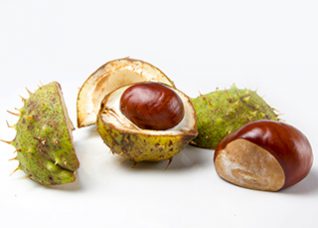
MinerAlert

MinerAlert
Aesculus hippocastanum
Castaño de Indias.

The dried seed.
Horse Chestnut is used mostly as a seed extract. For oral ingestion, tablets and tinctures are available. Suppositories are used against hemorrhoids. Externally, liquid extracts can be applied as gels, ointments or lotions. The raw seed is toxic. Do not confuse horse chestnut with sweet chestnuts. Sweet chestnuts belong to a different plant species and are non toxic.
Preparations made from the seed are used principally against circulatory disorders, such as varicose veins, hemorrhoids, chronic venous insufficiency and edema (abnormal accumulation of liquid under the skin).
Safety/Precautions:
Before you decide to take any medicinal herb or herbal supplement, be sure to consult with your health care professional first. Avoid self-diagnosis and self-medication: Always be on the safe side!